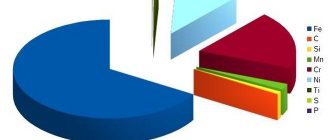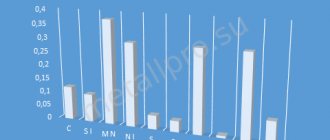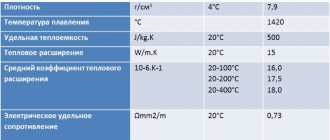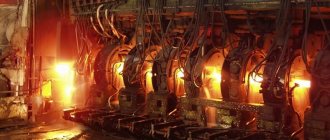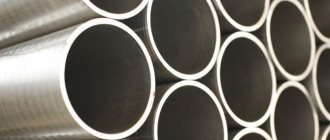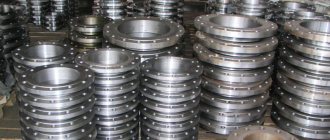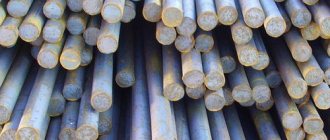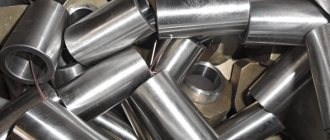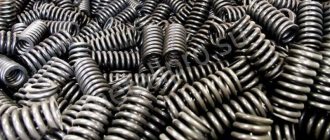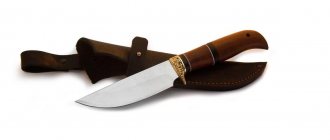Methods for determining steel grade
A fairly common question is how to determine the grade of steel. There are several common methods:
- The first involves removing chips from the surface, for which a chisel can be used. At high carbon concentrations it will be short and brittle. A decrease in the indicator causes an increase in plasticity. However, it is not possible to accurately determine the brand using this method.
- The second method involves hardening the product, after which it is necessary to make cuts. If the material is simply sawed before and after hardening, then it contains a small amount of carbon. Due to the increase in carbon concentration after treatment, the surface becomes too hard.
- Determining the steel grade by spark is based on a visual inspection of the sparks that are formed when processing the surface with a grinding wheel. With an increase in the size of the sparks and their number, the hardness index increases, which depends directly on the carbon concentration. Such a test does not give an accurate result, since the main characteristics of the flying chips depend on the force of pressing and some other points. You can find tables that decipher the qualities of a material based on chips.
Spark test method
Device for determining steel grade
You can also determine the brand by the color of the sparks produced. For this purpose, special tables were compiled. The test can be carried out at home only if the lighting is correct. However, it is impossible to accurately identify the material in this way. The option with alloying elements can also be identified by other performance characteristics, for example, resistance to high humidity or strong magnetism.
Determination by hardness
Manufacturers often use softer alloys to reduce the cost of products, such as cutlery. If it is not possible to order a laboratory analysis, you can use the following methods:
- Use a hardness tester - stationary or mobile. It shows a fairly accurate result in Rockwell units.
- Use a file or needle file. A high-quality tool is accompanied by documentation indicating its hardness. To check, a metal object must be secured in a vice and a file passed over it with medium pressure. If a mark remains, it means that it has less hardness than the tool.
- Impact with a reference sample of an alloy whose hardness is known. The part to be tested is fixed and a point blow is applied to it. If a dent forms on it, it means it is softer than the sample. If the impact mark remains on the standard, it means it is harder.
- Remove the shavings from the nail. Used to test a sharp object, such as a knife. Nail 100 is hammered halfway into a hard board using a knife and trying to remove shavings from it. If this works, then the hardness of the material is 50 units. The softer alloy is deformed from this action.
The above methods can be applied at home, but laboratory tests give the most accurate results. They are held in Krasnodar.
General concepts about steel grades
In the CIS, the applied designation standards are characterized by the fact that they can be used to indicate the main elements. When considering the issue of decoding the brand, we note the following points:
- The abbreviation “St” is often used. In other cases, no abbreviations are used at all, only numbers.
- In most cases, the first number indicates the carbon concentration. The following can be used to indicate the amount of alloying components.
- The composition may include alloying components that significantly change the properties of the material. An example is the inclusion of chromium, which increases resistance to high humidity.
Classification of steels by purpose
Labeling is deciphered using tables that indicate the designation of the chemical element.
Determination of steel grades by spark color
Determination of steel grades by spark color
Steel 12Х18Н9 - sparks are light yellow, short, in small quantities, almost without branches, with a red-yellow beam at the end of the branch and three to five small red grains at the branches. At the beginning of the spark there is a red-yellow beam from the touch of the workpiece to the abrasive wheel
Steel X12F1 - yellow sparks, short, thick stars, the ends of the threads are sharp with individual red grains. At the beginning of the spark there is a red-yellow beam from the touch of the workpiece to the abrasive wheel
Steel 12X13 - sparks are light yellow, short, with small bunch-like branches, with small red grains. At the beginning of the spark there is a red-yellow beam from the touch of the workpiece to the abrasive wheel
Armco iron - light yellow straight sparks without branches with two or three short red threads in the middle. At the beginning of the spark there is a red-yellow beam from the touch of the workpiece to the abrasive wheel
Steel grades St2 and StZ - sparks are light yellow, the branches are somewhat more developed and thinner than the thread itself; There are arrows at the ends of the sparks, there are no stars. At the beginning of the spark there is a red-yellow beam from the touch of the workpiece to the abrasive wheel
Steel 12ХНЗА - sparks are yellow, the branches are more developed and thicker, there are arrows at the ends of the sparks, there are no stars. At the beginning of the spark there is a red-yellow beam from the touch of the workpiece to the abrasive wheel
Steel 4 - light yellow sparks, branches thinner than threads and thicker than steel St2 and StZ, no stars. At the beginning of the spark there is a red-yellow beam from the touch of the workpiece to the abrasive wheel
Automatic steel 12 - light yellow sparks with thin branches and with a large number of stars: there are arrows at the ends of the threads, and in the middle of some stars there are weak red-yellow tufts. At the beginning of the spark there is a red-yellow beam from the touch of the workpiece to the abrasive wheel
Steel 10 - light yellow sparks with a small number of branches, a small number of elongated stars, the tips of the threads are sharp, in the middle of some stars there are weak red-yellow tufts. At the beginning of the spark there is a red-yellow beam from the touch of the workpiece to the abrasive wheel
Steel grades U8, U10 - light yellow sparks, more branches and stars than steel grades 15 and 20, with a large number of red-yellow tufts in the stars. At the beginning of the spark there is a red-yellow beam from the touch of the workpiece to the abrasive wheel
Steel grades 15, 20 - light yellow sparks, more branches and stars than steel 10, but there are less than three to five red-yellow tufts in the stars. At the beginning there is a beam from the touch of the workpiece to the abrasive wheel
Steel grades 25, 30 - sparks are light yellow, there are many branches, dense stars, the ends of the threads are thin, many stars have red-yellow grains in the form of peas. At the beginning of the spark there is a red-yellow beam from the touch of the workpiece to the abrasive wheel
Steel U12F - light yellow sparks, large dense stars, three to five stars have red-yellow tufts. At the beginning of the spark there is a red-yellow beam from the touch of the workpiece to the abrasive wheel
Steel grades 40ХН, ХНМ - sparks are light yellow, thick stars stand out in the center of the sparks, there are a small number of arrows at the ends of the threads, some stars have red grains. At the beginning of the spark there is a bright red beam from the touch of the workpiece to the abrasive wheel
Steel grades 20ХНМ, 20НЗ - yellow sparks, several bright stars stand out in the center of the sparks, at the ends of the sparks there are arrows and several red grains in the stars. At the beginning of the spark there is a bright red beam from the touch of the workpiece to the abrasive wheel
Steel grades 40, 45 - sparks are light yellow, the branches are highly developed, the branches have large stars, in the center of which there are red-yellow grains. At the beginning of the spark there is a light red beam from the touch of the workpiece to the abrasive wheel
Steel 38ХМУА - yellow sparks, arrows at the ends of the threads, and in the middle of the threads there are several large stars with small red grains. At the beginning there is a small light red beam from the touch of the workpiece to the abrasive wheel
Steel grades 4ХС, ЗОХГСА, 35ХГСА - sparks are light yellow, there are arrows at the ends of the threads, several light stars stand out at the branches with small light red grains in the middle. At the beginning of the spark there is a light red beam from the touch of the workpiece to the abrasive wheel
Steel grades X, KhG, ShKh15, ShKh9 - yellow sparks, on the branches there are a large number of large light red stars with small yellow grains in the middle. At the beginning of the spark there is a light red beam from the touch of the workpiece to the abrasive wheel
Steel 9ХС - dark yellow sparks with light red branches and a large number of stars with yellow grains in the middle. At the beginning of the spark, from the touch of the workpiece to the abrasive wheel, bright red tufts are obtained with a transition to light yellow and light red branches
Steel P9. The first type of definition is light crimson sparks with a yellow-red bunch at the beginning, the branches are simple and sparse with small yellow-red grains at the ends. At the beginning of the spark there is a bright red beam from the touch of the workpiece to the abrasive wheel
Steel P9. The second type of spark definition is dark crimson, threads with a bright yellow-red tuft at the beginning, branches with grains at the tips, with sparse and small branches. At the beginning of the spark there is a bright red beam from the touch of the workpiece to the abrasive wheel
Steel P18. The first type of definition is dark crimson sparks with a yellow-red beam at the beginning, straight threads, without branches with one or two light yellow grains, at the ends of the spark beam. At the beginning of the spark there is a light yellow beam from the touch of the workpiece to the abrasive wheel
Steel P18. The second type of definition is dark crimson sparks with a yellow-red tuft at the beginning, small branches at the ends of two or three threads, with light yellow grains at the ends of the tuft. At the beginning of the spark there is a bright red beam from the touch of the workpiece to the abrasive wheel
Steel ZX2V8 - dark crimson sparks, long threads with a bright yellow-red bunch at the end of the threads; the bunch contains grains with light yellow tips, with sparse and small branches. At the beginning of the spark there is a bright red-yellow beam from the touch of the workpiece to the abrasive wheel
HVG steel - dark crimson sparks, light and bright branches with small individual yellow-red tufts and specks. At the ends of short and long threads there are bright red stars with light yellow grains in the middle. At the beginning of the spark there is a bright red-yellow beam from the touch of the workpiece to the abrasive wheel
XB5 steel - dark crimson sparks, branches with yellow-red tufts and grains at the ends, some threads are lighter and brighter. At the beginning of the spark there is a bright red-yellow beam from the touch of the workpiece to the abrasive wheel
The most expensive types of stainless steel
The cost is affected by the amount of nickel in the alloy: in the cheapest types its content does not exceed 5%. The most expensive are high-alloy alloys containing nickel from 12%. The expensive scrap includes plumbing fittings and rings, wire and various electrical connectors (connectors, adapters, etc.). Matte (a by-product of non-ferrous metallurgy) with a nickel content of over 35% is also highly valued, although it is classified as slag.
But the most common steel grade is A2, containing approximately 10% nickel and 18% chromium. It is usually used to make household items. To find out the exact price, visit our collection point: to evaluate scrap, specialists must inspect the metal, assess the degree of contamination, composition and properties.
Let's talk about how to determine some properties of an unknown piece of steel. It is, of course, impossible to determine the grade of steel on the knee. We don't have a spectrometer in our pocket. And chemical analysis is inaccessible to most. However, we can still do something. Let's consider the popular method of determination - rust, stainless steel. Using a magnet. It is not magnetic, which means it is stainless steel. Magnetic, quite the opposite.
This method is only partially correct. The magnetic properties of steel depend on the composition and, as a consequence, on the structure of the steel. Stainless steels are ferritic. It is 11-17% chromium, some carbon and has magnetic properties. That is, they are magnetic. Austenitic steels, stainless steels: 18% chromium, 8% nickel. It is precisely they that do not have, or have to a lesser extent, magnetic properties. There are also combined austenitic-ferritic ones. This is when they squeezed a little nickel, add 2-4% of it and pile up to 25% chromium there. There are also martensitic stainless steels. 12-17% chromium and higher. They have a high carbon content and are hardened. That is, these are the steels with which we communicate most often. These are knife steels. Not just knives. Those that take hardening. Let's look at an example.
Stainless steel, at first glance. Has magnetic properties. The next spoon is also stainless steel. Does not have magnetic properties. The metal on some instruments is more magnetic than on others. Magnetic key, drill, chisel. That is, everything here is quite proven. From such products, where the composition is not “Chinese”, let’s say. This is quite understandable. And here is a small piece of construction. It's also magnetic. As we see, with a magnet we can determine, identify, in principle, stainless steel. But only austenitic. This, in principle, does not contradict the statement that a magnet can identify stainless steel. But we also cannot deny that other steel is not stainless steel if it is magnetic. Therefore, to determine corrosion and other properties, I propose to use an integrated approach. That is, we will, of course, consider magnetic properties.
5.1. Basic information about the crystalline structure of metallic bodies.
The study of the structure and properties of metals and their alloys is the science
of metallurgy,
the founder of which, as mentioned above, is the Russian scientist D.K. Chernov.
Scientists have found that all metals used in technology in the solid state have a crystalline structure, in particular, D.K. Chernov in 1878 first presented a scheme for the formation of the crystalline structure of steel. He established that the process of metal crystallization occurs in two stages:
1. Formation of crystallization centers (nuclei).
2. Growth of crystals from these centers.
First, the primary or main axes of the crystals grow, and then the axes of the upper orders (second, third, etc.) grow perpendicular to them (Fig. 5.1).
Such crystals resemble wood in appearance and are called dendrites (from the Greek for “tree”). During the growth process, the crystals move towards each other and at a certain moment join each other, as a result of which they acquire the appropriate shape. Such crystals are called grains (Fig. 5.2). The size and number of grains at the end of crystallization depend on the rate of nucleation and growth of crystals.
A characteristic feature of the crystalline structure of metallic bodies is the correct arrangement of their atoms in space, constituting a unique spatial atomic-crystalline lattice, which determines their special properties. The simplest elementary crystalline cell is considered to be cubic, the size of which is determined by the distance between atoms ( a
– cube edge length) equal to 1A 0 (angstrom); 1A 0 =1·10 -8 cm=1·10 -10 m.
Rice. 5.1. Crystal growth diagram
1 – primary axis; 2 – second order axis; 3 – third order axis
additional information
St.12Х18Н9 (AISI 304) gives a short spark, colored light yellow with a few red dots appearing from time to time. At the point of contact with the abrasive and at the ends of the branching, the spark beam has a red-yellow color.
St.X12F1 - yellow, short spark, multiple “stars”, the ends are elongated in a line. The area where the abrasive touches is red-yellow. Individual red dots throughout the entire beam.
St. 12X13 - light yellow short spark with branches.
Add a comment Cancel reply
You must be logged in to post a comment.
In practice, to approximately determine the chemical composition or grade of steel, they often resort to spark testing of metals.
In this case, you can quickly determine the chemical composition of steel (carbon content in it) without performing any chemical analyzes in the laboratory. To do this, a sample of the steel being tested must be processed on an emery wheel in a darkened room. By the color of the sparks, by the shape and length of the spark filaments, by the shape of the beam (Table 4.2), the grade of steel is judged, comparing them with the nature and color of the sparks of well-known grades of steel (see color insert).

